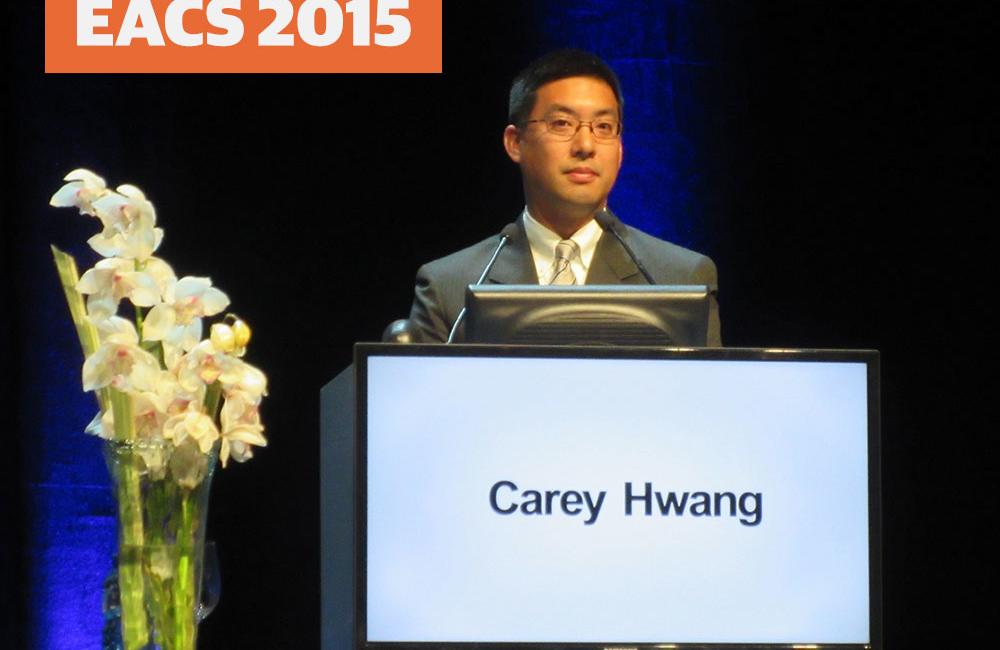
Bristol-Myers Squibb’s next-generation maturation inhibitor BMS-955176 demonstrated good antiviral activity against HIV subtypes B and C in a short proof-of-concept study and appeared to be safe and well-tolerated, according to findings presented last week at the 15th European AIDS Conference in Barcelona, Spain.
Effective antiretroviral therapy (ART) combines agents that target different steps of the HIV lifecycle, but none of the currently approved drugs interfere with viral assembly, maturation and release from host cells. Such drugs could offer an important treatment option for people who have HIV with extensive resistance to existing antiretroviral classes.
Once inside a host cell, HIV uses the cell’s machinery to produce large poly-proteins that are cut up by protease enzymes and assembled into new virions, or virus particles. The final steps include forming a capsid around new viral genetic material and budding out through the cell’s membrane, which results in a mature infectious virion.
Presenter Carey Hwang from Bristol-Myers Squibb explained that BMS-955176 interferes with protease cleavage between the viral p24 capsid protein and a smaller spacer peptide in the Gag poly-protein, leading to the release of immature virus that cannot go on to infect other cells.
An older maturation inhibitor candidate, bevirimat, initially showed promising antiviral activity, but about half of study participants had reduced susceptibility due to naturally occurring HIV Gag polymorphisms (genetic variations). BMS-955176, which binds more tightly with Gag, has shown in vitro activity against HIV that was not susceptible to bevirimat, as well as virus with resistance to approved antiretroviral drug classes.
Hwang presented overall antiviral activity and safety results from a phase 2a trial evaluating BMS-955176 in previously untreated and treatment-experienced people with HIV.
This study included three parts:
- Part A: 10-day monotherapy study in people with HIV subtype B (previously presented at this year’s Conference on Retroviruses and Opportunistic Infections).
- Part B: 28-day combination therapy with ritonavir-boosted atazanavir (Reyataz) in people with HIV type B (previously presented at this summer’s International AIDS Society conference).
- Part C: 10-day monotherapy study in people with HIV subtype C.
In Part A, researchers tested six different once-daily oral doses of BMS-955176 (ranging from 5mg to 120mg) or placebo in 60 treatment-naive and treatment-experienced people with HIV subtype B, while in Part C they tested just the 40mg and 120mg doses or placebo in 19 people with subtype C. Hwang noted that it is important to test BMS-955176 against both subtypes because they have different Gag polymorphism profiles.
All but one participant in Part A and 12 in Part C were men, most were white, the median age was about 37 years and the mean CD4 cell count was approximately 485 cells/mm3.
The three highest doses (40, 80 and 120mg) demonstrated potent antiviral activity, producing maximum viral load declines of 1.55 to 1.70 log10 in Part A and -1.35 to 1.26 log10 in Part C. Among the participants with HIV subtype B, declines were similar for people with various baseline Gag polymorphisms. BMS-955176 showed activity up to seven days after last dose, indicating a long half-life in the body.
Part B enrolled 28 adults with HIV subtype B. All were men, most were white, the median age was about 33 years and the mean CD4 count was approximately 550 cells/mm3. They could be either treatment-naive or previously treated with drugs other than HIV protease inhibitors or maturation inhibitors.
Participants were randomly assigned to receive 40 or 80mg BMS-955176 plus either 300/100mg atazanavir/ritonavir or 400mg unboosted atazanavir. A control group received standard therapy using boosted atazanavir plus tenofovir/emtricitabine (the drugs in Truvada). Treatment lasted for 28 days, with follow-up through day 42.
Viral load declined rapidly in all treatment arms. Median maximum viral load decreases ranged from -1.86 to -2.23 log10 in the BMS-955176 arms, compared to -2.39 log10 in the standard therapy arm.
Short-term treatment with BMS-955176 was generally safe and well-tolerated, with no deaths, serious adverse events or study discontinuations due to adverse events. The most common side-effects were headaches and abnormal dreams. Two people developed neutropenia.
A majority of people who used ritonavir-boosted atazanavir either with BMS-955176 or tenofovir/emtricitabine experienced grade 3-4 bilirubin elevations – a known side effect of atazanavir – but this occurred in just a quarter of people using unboosted atazanavir.
“In this phase 2a study, BMS-955176 80 demonstrated potent antiviral activity against both HIV-1 subtype B (as monotherapy or with atazanavir +/- ritonavir) and subtype C (as monotherapy),” the researchers concluded.
They added that “BMS-955176 has similar antiviral activity against both wild-type HIV-1 and HIV-1 with Gag polymorphisms not responsive to a first-generation maturation inhibitor.”
Hwang suggested that BMS-955176 has the potential to be useful in booster-sparing and nucleoside/nucleotide-sparing regimens, which could benefit people who cannot tolerate or have contraindications to using these drug classes.
Phase 2b trials of BMS-955176 are now underway, including a dose-finding study for treatment-naive people with HIV (NCT02415595) and a study evaluating BMS-955176 plus boosted or unboosted atazanavir and dolutegravir (Tivicay) for treatment-experienced patients (NCT02386098).
Hwang C et al. Second-generation HIV-1 maturation inhibitor BMS-955176: overall antiviral activity and safety results from the phase IIa proof-of-concept study (AI468002). 15th European AIDS Conference. Barcelona, abstract PS10/5, 2015.
